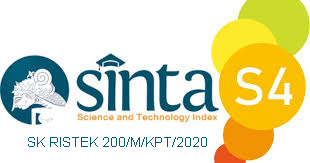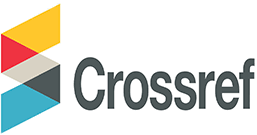South German Credit Data Classification Using Random Forest Algorithm to Predict Bank Credit Receipts
Abstract
Keywords
Full Text:
PDFReferences
A. T. Rahmawati, M. Saifi dan R. R. Hidayat, “Analisis Keputusan Pemberian Kredit dalam Langkah Meminimalisir Kredit Bermasalah,” Jurnal Administrasi Bisnis, vol. 35, no. 1, pp. 179-186, 2016.
S. Somadiyono dan T. Tresya, “Tanggung Jawab Pidana Marketing Menurut Undang Undang Perbankan Terhadap Pembiayaan Bermasalah di Bank Muamalat Indonesia,Tbk,” Jurnal Lex Specialis, vol. 21, pp. 22-38, 2015.
S. Masripah, “Komparasi Algoritma Klasifikasi Data Mining untuk Evaluasi Pemberian Kredit,” Bina Insani ICT Journal, vol. 3, no. 1, pp. 187-193, 2016.
W. Gan, J. C.-W. C. H.-C. Lin dan J. Zhan, “Data mining in Distributed Environment: A Survey,” Wiley Interdiscriplinary Reviews: Data Mining and Knowledge Discovery , vol. 7, no. 6, pp. 1-19, 2017.
S. Umadevi dan K. S. J. Marseline, “A Survey on Data Mining Classification Algorithms,” dalam International Conference on Signal Processing and Communication, Coimbatore, India, 2017.
“Kaggle,” kaggle.com, 2020. [Online]. Available: https://www.kaggle.com/c/south-german-credit-prediction/overview/data-overview. [Diakses 2 November 2020].
A. S. More dan D. P. Rana, “Review of Random Forest Classification Techniques to Resolve Data Imbalance,” dalam International Conference on Intelligent Systems and Information Management, Aurangabad, India, 2017.
A. Parmar, R. Katariya dan V. Patel, “A Review on Random Forest: An Ensemble Classifier,” dalam International Conference on Intelligent Data Communication Technologies and Internet of Things, Springer, Cham, 2018.
W. Chen, X. Xie, B. Pradhan, H. Hong, D. T. Bui, Z. Duan dan J. Ma, “A Comparative Study of Logistic Model Tree, Random Forest, and Classification and Regression Tree Models for Spatial Prediction of Landslide Susceptibility,” Catena , vol. 151 , pp. 147-160, 2017.
M. S. Hasibuan, Dasar-Dasar Perbankan, Jakarta: PT Bumi Aksara, 2004.
R. Widayati dan M. Efriani, “Aktivitas Pemberian Kredit Usaha Pada PT. Bank Perkreditan Rakyat Batang Kapas,” dalam OSF Preprints, Batang, Indonesia, 2019.
B. Panuntun dan Sutrisno, “Faktor Penentu Penyaluran Kredit Perbankan Studi Kasus Pada Bank Konvensional Di Indonesia,” Jurnal Riset Akuntansi & Keuangan Dewantara, vol. 1, no. 2, pp. 57-66, 2018.
M. S. Başarslan dan I. D. Argun, “Classification Of A Bank Data Set On Various Data Mining Platforms,” dalam Electric Electronics, Computer Science, Biomedical Engineerings' Meeting (EBBT), Istanbul, Turkey, 2018.
D. Tomar dan S. Agarwal, “A survey on Data Mining approaches for Healthcare,” International Journal of Bio-Science and Bio-Technology, vol. 5, no. 5, pp. 241-266, 2013.
V. Krishnaiah, G. Narsimha dan N. Chandra, “Diagnosis of Lung Cancer Prediction System Using Data Mining Classification Techniques,” International Journal of Computer Science and Information Technologies, vol. 4, no. 1, pp. 39-45, 2013.
K. Sumiran, “An Overview of Data Mining Techniques and Their Application in Industrial Engineering,” Asian Journal of Applied Science and Technology, vol. 2, no. 2, pp. 947-953, 2018.
L. Breiman, “Random Forests,” Machine Learning, vol. 45, pp. 5-32, 2001.
C. Yoo, D. Han, J. Ima dan B. Bechtel, “Comparison Between Convolutional Neural Networks and Random Forest for Local Climate Zone Classification in Mega Urban Areas Using Landsat Images,” Journal of Photogrammetry and Remote Sensing, vol. 157, pp. 155-170, 2019.
J. Chen, K. Li, Z. Tang, K. Bilal, S. Yu, C. Weng dan K. Li, “A Parallel Random Forest Algorithm for Big Data in a Spark Cloud Computing Environment,” IEEE Transactions on Parallel and Distributed Systems, vol. 28, no. 4, pp. 919-933, 2017.
J. Lin, H. Chen, S. Li, Y. Liu, X. Li dan B. Yu, “Accurate Prediction of Potential Druggable Proteins Based on Genetic Algorithm and Bagging-SVM Ensemble Classifier,” Artificial Intelligence In Medicine, vol. 98, pp. 35-47, 2019.
A. Jeyaraj, R. S dan M. R. Raja, “A study of classification algorithms using Rapidminer,” International Journal of Pure and Applied Mathematics, vol. 119, no. 12, pp. 15977-15988, 2018.
DOI: https://doi.org/10.31326/jisa.v3i2.837
Refbacks
- There are currently no refbacks.
Copyright (c) 2020 Yoga Religia, Gatot Tri Pranoto, Egar Dika Santosa

This work is licensed under a Creative Commons Attribution-ShareAlike 4.0 International License.
JOURNAL IDENTITY
Journal Name: JISA (Jurnal Informatika dan Sains)
e-ISSN: 2614-8404, p-ISSN: 2776-3234
Publisher: Program Studi Teknik Informatika Universitas Trilogi
Publication Schedule: June and December
Language: English
APC: The Journal Charges Fees for Publishing
Indexing: EBSCO , DOAJ, Google Scholar, Arsip Relawan Jurnal Indonesia, Directory of Research Journals Indexing, Index Copernicus International, PKP Index, Science and Technology Index (SINTA, S4) , Garuda Index
OAI address: http://trilogi.ac.id/journal/ks/index.php/JISA/oai
Contact: jisa@trilogi.ac.id
Sponsored by: DOI – Digital Object Identifier Crossref, Universitas Trilogi
In Collaboration With: Indonesian Artificial Intelligent Ecosystem(IAIE), Relawan Jurnal Indonesia, Jurnal Teknologi dan Sistem Komputer (JTSiskom)
JISA (Jurnal Informatika dan Sains) is Published by Program Studi Teknik Informatika, Universitas Trilogi under Creative Commons Attribution-ShareAlike 4.0 International License.


















